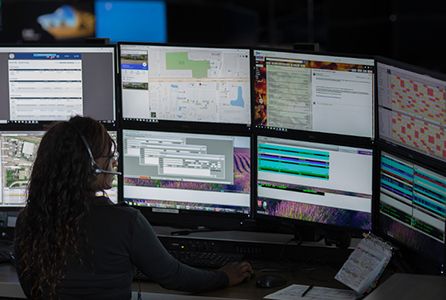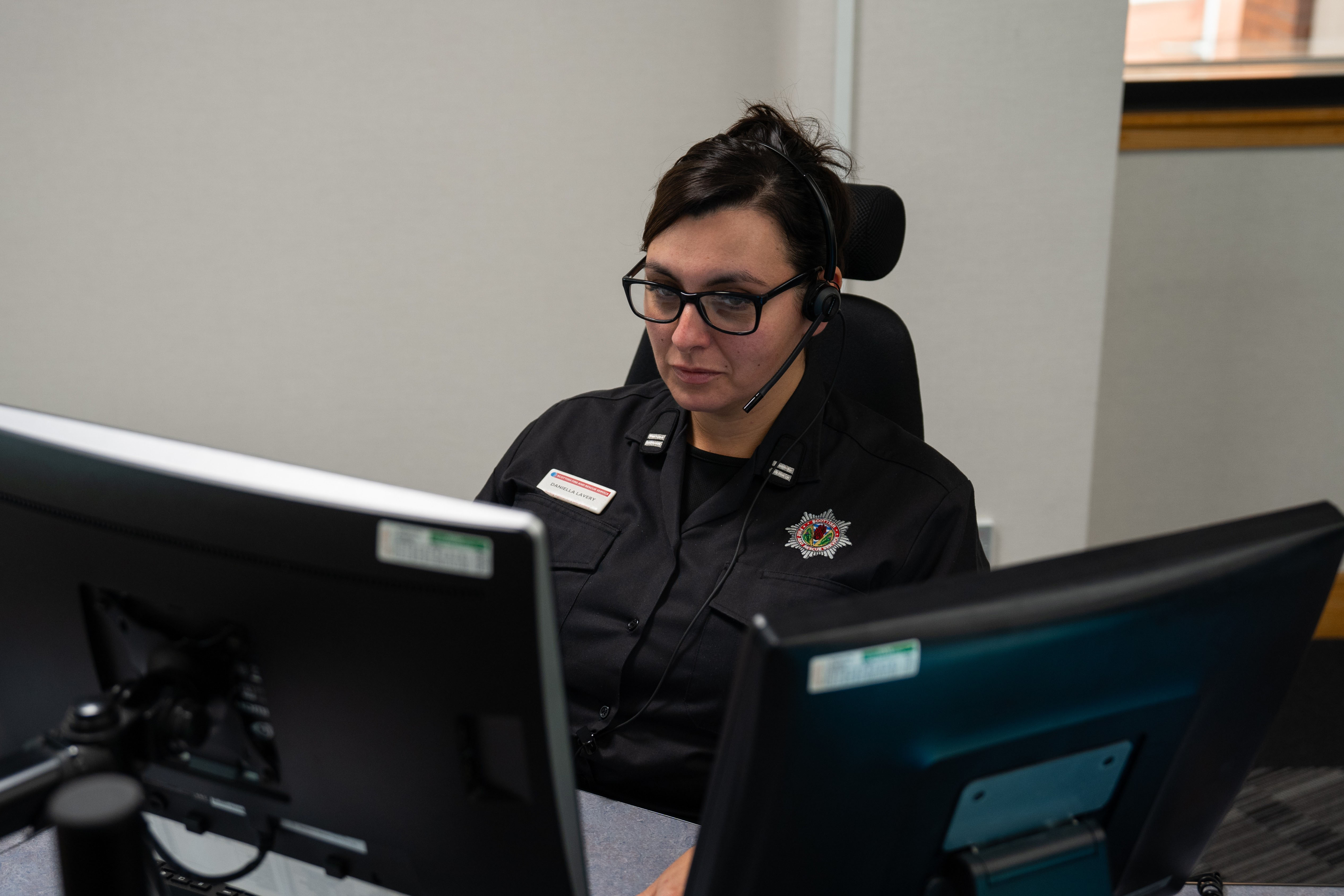In honour of International Control Room Week, we’re taking a deep dive into the history of control room technology to discover how technology has transformed the way we contact our emergency services – from the humble beginnings of the police phone box 150 years ago, to the promise that artificial intelligence (AI) holds for the emergency services today and into the future.
1870s and 1880s: Pull-handle street boxes and telephone boxes
The first ever street fire alarm system was devised by the Glasgow Fire Brigade in 1878, and leveraged the most cutting-edge technology at the time: telegraphs. By pulling the box handle, a member of the public could send a telegraph to the nearest fire station – a revolutionary idea, compared to the previous word-of-mouth tactics that the public were forced to resort to in the first half of the 1800s.
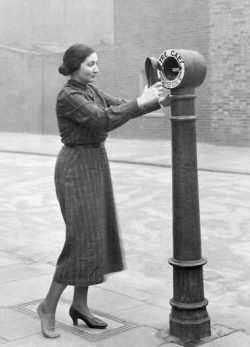
A pre-war street fire alarm
The next leap forward occurred just two years later, when the city of Chicago installed the first police box – only four years after Alexander Graham Bell invented the telephone itself. They weren’t introduced to the UK until the 1920s, when Sunderland pioneered the concept of police boxes as a mini station for officers. Much like the Pronto digital policing app developed by Motorola Solutions almost a century later, these boxes were intended to save time for frontline officers by reducing the need to travel long distances to a home station.
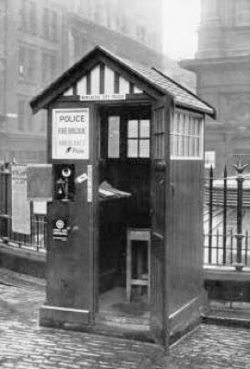
A police box in Newcastle, 1928 (credit: policeboxes.com)
In addition to containing stretchers, fire hoses and even toilets, these police boxes were also equipped with telephones. This gave them a duality of purpose: not only could officers place calls back to the station, but members of the public could also contact their local police force when out and about.
1930s: Adoption of 999
After a particularly disastrous fire in 1935 killed five women at 27 Wimpole Street, London, a committee set up by the General Post Office (who were then responsible for the network) advised that the United Kingdom should introduce a short, simple number for dialling emergency calls. Then-commander for the information room at Whitehall, Tom Fallon, played a crucial role in the decision to establish 999 as the new emergency number – partly because it couldn’t be dialled accidentally (unlike 111, which was sometimes falsely generated when telephone wires flapped in high winds), and partly because it could be dialled easily even when users were unable to see the telephone itself. In an act of serendipity, it was also the number on his patrolman’s badge.
During its first full week of operation in 1937, in London, the service handled 1,000 calls, and aided in its first arrest – in comparison, the Metropolitan Police now handles 6,000 emergency calls every day.
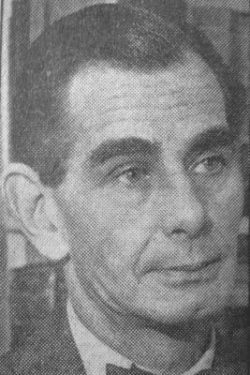
Tom Fallon, the man who decided “999” would be the British emergency number back in 1937
Obviously, unlike modern integrated communications control systems, no sophisticated call stacks existed in the 1930s – instead, when an emergency call came in, operators in the control room would be alerted via a klaxon and flashing red lights.
1990s: Dual-code pragmatism
While the UK was rolling out 999 countrywide in the 1970s, the European Union was in parallel discussions about introducing a unified emergency number for all member states. On 29th July 1991, they passed the council decision to introduce a new number – 112 – which all member states had to adopt by 1996. Importantly, to minimise confusion, the council ruled that 112 could co-exist with previously-established emergency numbers (although some member states, such as Denmark and Finland, chose to use 112 as their only emergency number instead).
The council laid out its reasoning for introducing 112 as follows: “[differences in emergency numbers create] problems in contacting the responsible services for citizens facing emergency situations in other Member States… The substantial increase in both private and business travel within the Community has created a demand for the introduction of a single European emergency call number… the introduction of new technologies in public telephone networks and the coordinated introduction of advanced telecommunications infrastructures present a unique opportunity for the implementation of a single European emergency call number.”
In 1993, the UK introduced 112 as an emergency number alongside 999. While no new data has been reported since the UK left the EU in 2016, the most recent numbers suggest that around 96% of emergency callers used 999 instead of 112. Crucially, however, maintaining two numbers simplifies the process for travellers from the EU – without adding complexity for operators in the control room.
As of 2024, 62% of all emergency calls in the EU were placed via 112, up from 56% in 2021; this represents a massive increase in usage, considering that only 26% of respondents were aware of the unified number’s existence back in 2012.
2010s: Advanced Mobile Location (AML)
With the advent and growing ubiquity of smartphones in the mid-2010s, emergency call handling technology evolved yet further to take advantage of the new capabilities offered by Android and iOS platforms. Now, when a smartphone user contacts the emergency services, Advanced Mobile Location (AML) will automatically use the GNSS or WiFi on the phone to send an accurate location to the control room. The European Commission found that AML can save up to 45 seconds per call and improves location accuracy up to 17 times. On an individual level, the positive impact that AML has had on the emergency services cannot be overstated; for example, it helped the Slovenian ambulance service locate a car accident on the motorway when the caller was too distressed to provide an address.
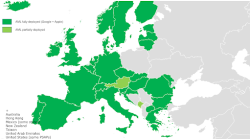
Countries where AML has been deployed (credit: EENA)
What’s next?
The challenges facing emergency services are greater than ever. There has been a 20% increase in callouts for FRSs since 2015, but FRS budgets in the UK have shrunk by £1bn. In a similar vein, there has been a 31% increase in non-emergency calls to ambulance services since 2019. Artificial Intelligence (AI) shows significant potential to save both time and money for emergency services that are currently under considerable strain. From real-time two-way translation to intelligently triaging designated non-emergency calls, technology providers have the opportunity to revolutionise the control room and improve the working conditions for those answering calls.
At Motorola Solutions, we recognise that AI can never replace human judgement – which is why we’re designing tools that keep your staff in the driver’s seat. For example, when we introduced AI audio enhancement into Guardian ICCS, we ensured that operators could choose when to enable the tool, while also enabling them to manage the exact level of noise cancellation on a call-by-call basis. By bringing former control room professionals onto our team and working in close partnership with our customers, we’re developing technology that can augment human effort and performance – continuing a tradition that started with the original street alarm system way back in 1878.
For more information about our control room solutions, please visit motorolasolutions.com/guardian.

